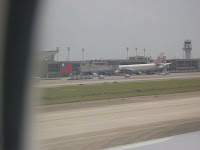
I left the hotel mid-afternoon, ready to jump on the MRT and explore Taipei. My first destination was to be the iconic Taipei 101, one of the tallest buildings in the world. It certainly stands out at more than a 1,000 feet tall. But what is striking is that it is the only really tall building around. Singapore, Hong Kong, Bangkok - they all have clusters of skyscrapers that make up their skylines. Taipei 101 stands alone, towering over its neighbors.

Architecturally, the building is a marvel. Its design brings to mind a bamboo stalk, symbolic of the strength of the native plant. It is eight sections of eight floors each, sitting on a truncated pyramid. A high speed elevator takes you from the fifth to the 89th floor in 37 seconds, or 1000 metres/minute (the ride down takes all of 45 seconds, or 600 metres/minute). Once there, you get a panoramic view of the city, as well as access to the outdoor observation area on the 91st floor and the damper on the 88th.
The outdoor area is ringed by vertical metal bars to keep visitors out of danger. With the strong wind at that height, they act as musical instruments, and a constant whistle could be heard as you walked around the roof.


The tuned mass damper will be of interest to the engineers out there. This 5-metre tall sphere is suspended by cables stretching from the 92nd to the 87th floors. Weighing 728 tons, it sways to offset movements in the building caused by strong winds. The observation level for the damper is well done itself - it is eerily quiet in the damper chamber, but the hallways leading into it feature cool illuminated floors that show aerial photos of the city and star scenes.



The tower itself, while an amazing architectural achievement, has actually been blamed by some to cause small earthquakes, because of its massive size and weight. I don't know about the validity of such claims, but it was a good spot to start my visit.



